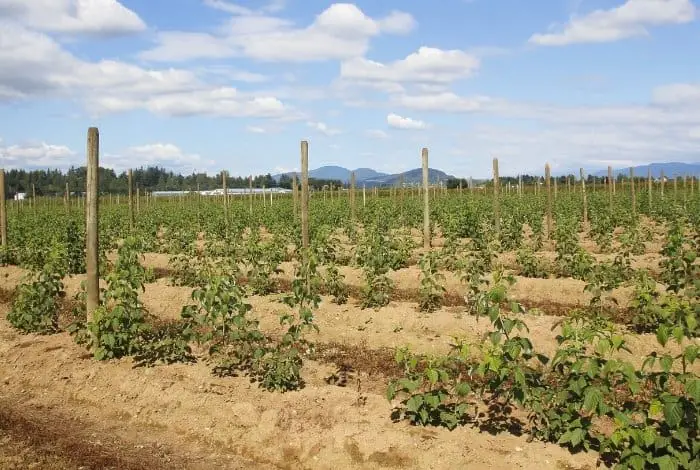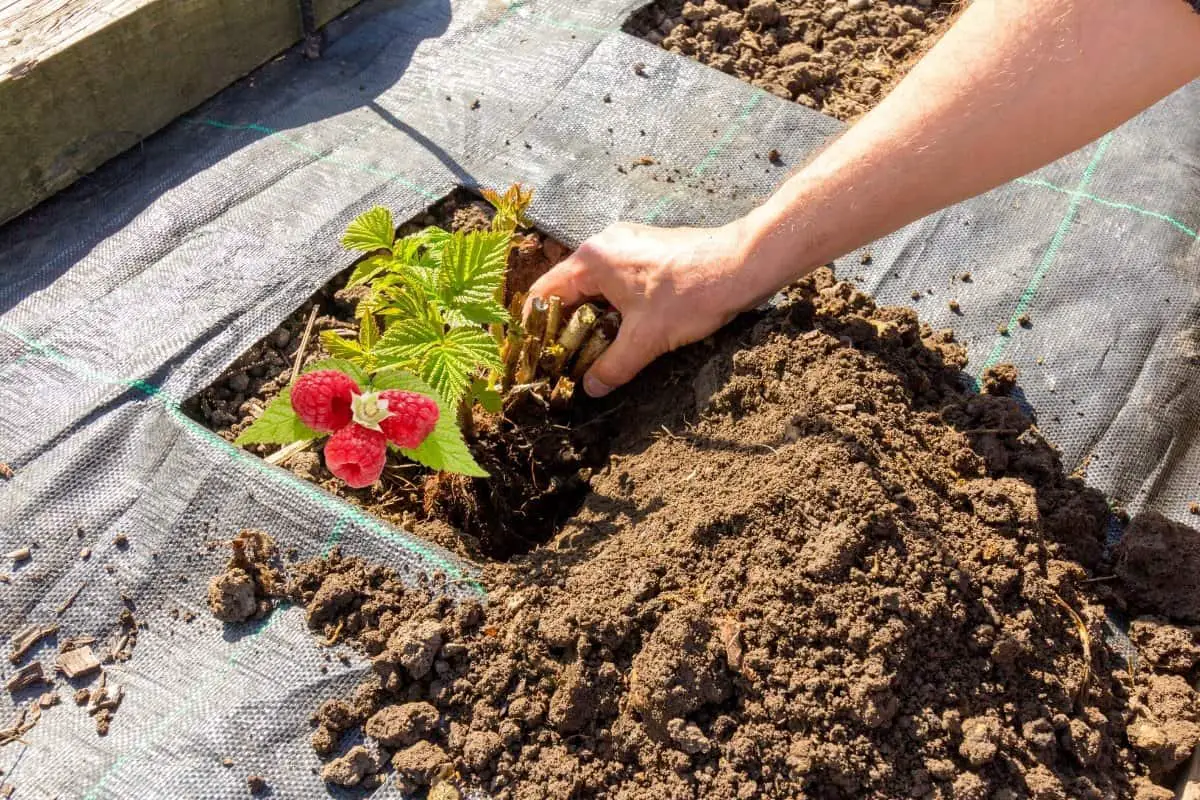Last Updated on January 5, 2022 by
If you choose the best place to plant raspberries, you are assured of a bountiful harvest year after year with proper care.
Growing raspberry bushes is a fantastic way to make your jams and jellies. Raspberries are high in Vitamin C and A; they not only taste good but they are a healthy option for you as well.
They can be harvested from mid-summer through to the first day of frost. Growing raspberries bushes is easy and will reward your efforts but you need to choose the best place to grow them.
Choosing The Best Place to Plant Raspberries
- Raspberries do well in a sunny area but unlike many other fruits, they still do well in a partly shaded area. But the more sun, the more fruit you harvest.
- The best place to plant raspberries needs to have rich and well-drained soils, perfect shelter from wind, and excellent air circulation. Avoid wet areas and windy spots because raspberries do not like to stand in water for long or get dried out.
- To get a better harvest each year, add a couple of inches of compost or aged manure and water regularly.
- Do not plant your raspberries near wild berries. You risk spreading the wild berries diseases and pests to your cultivated raspberry plants
6 barerot plant Joan J Thornless Everbearing Red Raspberry -Huge 2 Yr.
Types Of Raspberries
Ever-bearing Raspberries – also known as fall-bearing or autumn bearing produces fruits on new canes. This variety bears a fall crop and can also produce fruit the following summer.
Summer-fruiting Raspberries – these are more common and develop their fruit depending on last year’s growth. They bear only one harvest per season during summer time – June or July.
Mixing both types of berries is ideal as it maximizes your harvest. Raspberries are self-fertile thus you only need one bush to produce fruit. They are pollinated by bees and start producing fruit 1 year after planting.
Check Out When To Plant Blackberry Bush
How To Grow Raspberries
- Before planting, you need to soak the roots for at least an hour or two
- Dig a hole that is big enough for the roots to spread well. If you are planting many bushes, dig a trench for easier planting.
- Keep the crown of the plant about 1 to 2 inches above the ground whether you are planting potted plants or bare root.
- Place the canes at least 18 inches apart with about 4 feet between the rows.
- Once you have planted, fill the soil back in and tamp it down with your foot.
- Cut down the planted canes to about 9 inches to encourage new growth.
- Depending on the variety you plant, you will need to come up with support to hold up the canes. A fence or trellis is a good option. If you plant using rows, put 2, 6-foot posts at the end of each row and stretch the galvanized wire between the posts. Summer fruiting raspberries will require 3 horizontal wires while the fall variety requires 2 wires.

Raspberry Bush Care
Watering: Water your plants 1 inch per week from spring until after you harvest. Regular watering is preferred over infrequent deep watering.
Mulching: To preserve soil moisture and suffocate weeds, mulch your plants. Keep a thick layer of mulch surrounding your plants at all times.
Dig up suckers: Keep your raspberries tidy by digging up any canes or suckers that grow away from the rows. If you keep them, they will draw nutrients from the main plant making them produce fewer berries. The suckers you dig up can be replanted in freshly prepared ground.
Read more about Choosing the Best Blueberry Fertilizer
Pruning Raspberries
It is advisable to prune summer-fruiting raspberries immediately after you finish picking. Cut the canes that produce berries back down to help them yield better. This variety produces berries on 2-year-old canes while 1 year old grows beside them. You should not have trouble telling which is which. The older canes have brown stems while the young ones are still green. Prune the older ones only, they are the ones that have finished fruiting.
The remaining canes are tied to the supporting wires with a garden string. Use a cane every 4 inches of wire for better support.
For fall-bearing raspberries, cut down all the canes back to the ground in late winter before the next growth begins in the spring. This variety gives fruit on canes which disappears after the first year of growth. Therefore there is no reason to keep them. Use pruning shears or mow them to the ground.
Pruning is not done during the growing season unless you want to keep your plants in a certain order.
Where To Plant Raspberries
Now that you know how to grow raspberries, go ahead and exercise your knowledge. Sometimes the best teacher is the practical application.
FAQs
Where Is The Best Place To Plant Raspberries
Raspberries are a large fruit that can be grown in many different climates and with many different types of soil. In order to grow your own, you should choose a location that receives full sun most of the day for at least five hours with temperatures from 10 degrees Celsius to 30 degrees Celsius or more. These plants need to be in warm soil where they can grow healthily. There are two main techniques used when planting raspberries: hedge rows and matted rows.
In the late summer following the raspberry season, it's important to prepare a bed for new growth. To prepare a bed for new growth, remove all weeds and sod from the area. Till the soil to a depth of 12 inches and add organic material such as compost, peat moss or manure. Mound up soil in rows spaced 4 feet apart and sow the raspberries in these mounds.
What should not be planted next to raspberries?
Some plants that aren’t good for the soil, like potatoes, should never be planted next to raspberries. Planting raspberry plants with sorrel plants will not result in a successful outcome.
Raspberries produce a lot of shade and need a lot of room to grow. This means that they should not be planted next to any plants that require more sun than they do. If a person would plant a walnut tree next to the raspberry patch, then it will block sunlight from reaching the raspberry plants and they will not thrive.
Some plants are good for the soil while others are not. Plants that are good for the soil are called “crop rotation crops.”
Do raspberry plants spread?
Raspberry plants can spread through runners, which can grow and re-root themselves on the ground and on other host plants.
They are hardy enough to grow in most conditions of soil and climate. This means that they can spread very quickly, if they are not checked. One way to keep your raspberry plant healthy is to keep it well-watered so it doesn’t spread too much.
When should you plant raspberry bushes?
Raspberries can be planted anytime from winter to early spring, but they should be planted as soon as the ground is ready to work. The ground should be dry and the weather has to be relatively warm. The best time for planting raspberry bushes is in late summer or early fall.
Planting raspberry bushes outside of this time period may result in low yield because the plants are not yet mature enough to produce enough fruit.
Raspberries will not tolerate frost. They require at least six hours of sunlight each day. Planting raspberry bushes in the late fall or early spring is the best time to plan for a successful crop.
The plant needs to be watered well when it is first planted in the ground. It also needs to be fertilized with compost annually during the spring months.
Caroline is a gardener who loves to get down to the nitty–gritty of gardening. She proudly proclaims herself as a ‘dirt worshipper‘ and can often be found deep in the garden, covered in soil and singing to her plants. As a self–proclaimed ‘plant whisperer‘, Caroline believes that plants need love and attention just like any other living thing, and she loves to give them both. When she‘s not tending to her garden, you can often find her researching the latest gardening trends, or teaching others how to make their gardens thrive


